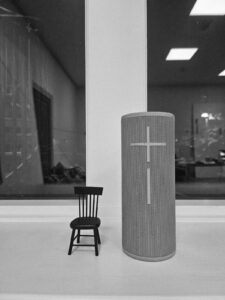FILLING
is a playful installation that reveals the artistic method and process behind the independent artistic research entitled 18 steps through (stories of) dance.
Since its initiation in 2019, traces of it have been manifested in different artistic and academic formats:
-My Body is a room filled with … (2021)
– The GAP (2023)
– BGL- podcast (2024-)
– MFA- thesis: Steps towards dance literacy @ SKH (2025)
– House of the pelvic floor (in the future)
My interest lies in how the archive of dance and choreography can serve as a tool, a kind of knowledge-apparatus, that enhances a deeper understanding of how aesthetic borders are formed, dissolved or re-instituted and why.
Through FILLING i also wish to show that being a danceartist is not only about strong legs and sweaty training. Before movement, before choreography there is a search and a re-search. For me it is a continuous dwelling on and investigation of the history of the dance as an artform in itself, particularly within the context of western aesthetics. A context within which I have been working as dancer, as a choreographer and as a pedagogue. Investigating the history, tracing the archives and stories of dance, from different angles, has become one of the main methods in my artistic practice as a dance artist. In simple words, I need to read, see, hear dance to make more dance.
With the help of two fictitious, critical-yet-humorous guides (Zav Elita and Dolores von Glores), I aim to draw attention to how aesthetics not only shape what kinds of dance we consider compelling or legitimate, but also how they reflect deeper cultural ideals and biases.
FILLING doesn’t stop. It remains an ongoing space—a splace for filling the gaps of knowledge and imagination between past, present, and future.
The project received its initial start-up funding from the City of Gothenburg in 2023. Since then, I continue to develop it whenever opportunities arise—most recently during a residency organized by DC Väst in Gothenburg.
1.TIMELINES
what triggered my initiative interest to create this installation was looking at timelines and how the way a timeline is “choreographed” defines one’s understanding of what is considered valuable in an artform. In his book “Stories of art”, art historian James Elkins proposes to rethink the traditional narrative structure of art history. He challenges the linear, Eurocentric canon that often presents a singular progression of artistic value. Elkins suggests that art history should be pluralized, comprised of many overlapping, conflicting, or even contradictory stories, rather than one dominant timeline
In curating this installation, I wanted to question these mechanisms by disrupting the normative timeline of Western dance history. I removed names and dates, leaving only the places. What this revealed was a timeline that carries a distinctly Western, Eurocentric bias, simply through geography. Here I divided the thread in one century per meter.
Zav Elita will inform you more on the topic in this video:
2.Canons
The discussion on canons and icons can spark heated discussions. It can seem contradictory to focus on them after having discussed decentralisation. This is precisely where I want to challenge the common assumptions around decentralisation. Moving away from geographic or institutional centers does not mean we must abandon or forget the canons of the past. In fact, we need them. These are keys to understanding changes in aesthetics.
Let Zav Elita and Dolores von Glores break it down for you:
3. Icons
An Icon is per definition a result of multiple, overlapping sociocultural forces: media attention, institutional validation, critical reception, public recognition etc. Think The Beatles, Madonna, Maradonna, Marlon Brandon, Nelson Mandela. Unlike canons, which can be expanded, revised, or even redistributed, icons remain singular. Western dance history has many canons, but it has fewer icons. I start by bringing your attention to one of them, Pina Bausch. She lived and worked in the periphery, in a city called Wuppertal, that only appears once over a four century long timeline. Her legacy isn’t necessarily rooted in choreography alone. What marks her iconic status is the aesthetic impact she made across generations of choreographers.
Without Pina there would not be THE CHAIR. Since Bauschs iconic piece ”Cafe Müller” chairs, litteraly, entered the stage of modern and contemporary dance like never before. What would the 80’s and early 90’s do without chairs.
I thought of writing a chairs memoir by simply focusing on the sounds it has heard. The chair is in a way an iconic scenography item in the history of western dance.

4. Intertextuality
5. 18 steps structure
